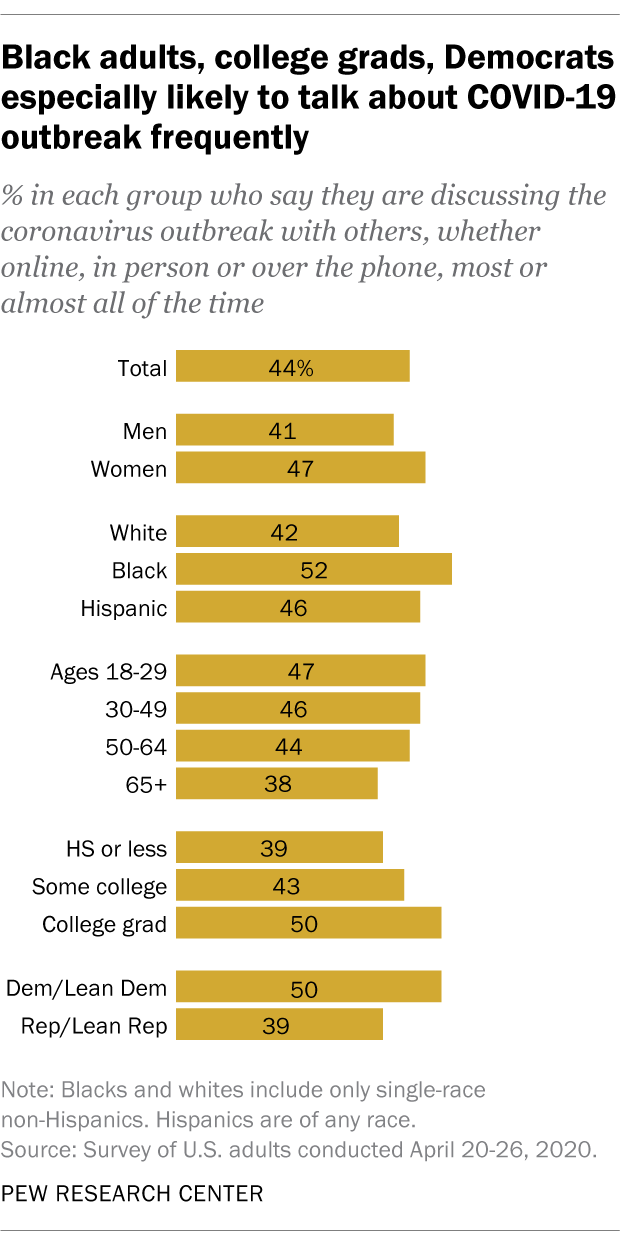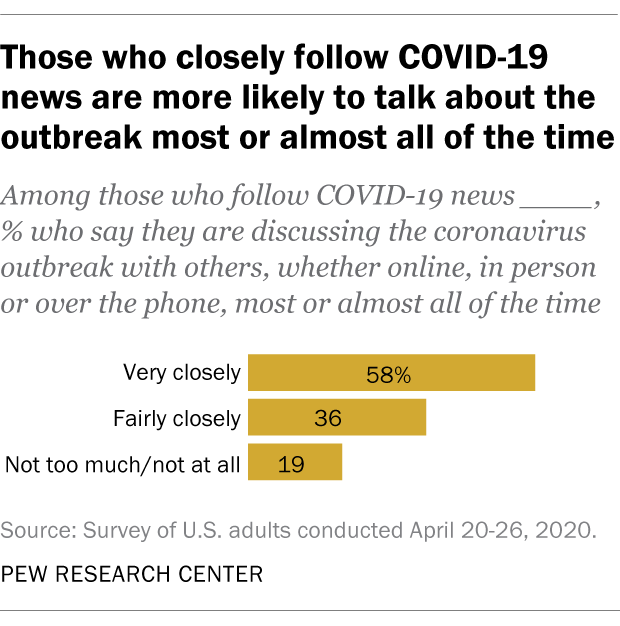
Most Americans say they need to take breaks from COVID-19 news. But that doesn’t mean they are avoiding the topic completely. In fact, 44% of U.S. adults say they are discussing the coronavirus outbreak with other people most or almost all of the time, whether online, in person or over the phone, according to a Pew Research Center survey conducted April 20 to 26.
[callout align=”alignright”]
Want to see more data on these questions?
To analyze these survey questions by additional demographic characteristics and media habits, visit the data tool.
[/callout]The outbreak has had far-reaching effects on daily life in the United States, so it may not come as a surprise that it is such a frequent subject of discussion for many Americans. In early April, more than four-in-ten adults (43%) said they or someone in their household had lost their job or taken a pay cut due to the outbreak, while around a quarter (24%) said they were very concerned about contracting the virus and requiring hospitalization. The widespread stay-at-home orders that have resulted from the outbreak have upended more regular aspects of life, too, from the way Americans worship to how they shop for food and socialize with their friends and family.
Overall, 31% of adults say they are discussing the outbreak with other people most of the time, while another 13% say they are talking about it almost all the time, according to the late April survey, which was conducted as part of the Center’s American News Pathways project. The largest share of Americans (45%) say they sometimes discuss the coronavirus outbreak with other people, while 11% say they hardly ever or never discuss it with others.
This analysis about how frequently Americans talk about the coronavirus outbreak with other people is based on a Pew Research Center survey of 10,139 U.S. adults conducted April 20 to 26, 2020. Everyone who took part is a member of the Center’s American Trends Panel, an online survey panel recruited through national, random sampling of residential addresses.
Recruiting our panelists by phone or mail ensures that nearly all U.S. adults have a chance of selection and gives us confidence that any sample can represent the whole population. (See our Methods 101 explainer on random sampling.) To further ensure that each survey reflects a balanced cross section of the nation, the data is weighted to match the U.S. adult population by gender, race, ethnicity, partisan affiliation, education and other categories.
Here are the questions asked in this survey, along with responses, and its methodology.
 There are some modest demographic differences in how often Americans talk about the outbreak. Women are more likely than men (47% vs. 41%) to say they talk about it most or almost all of the time, as are black adults (52%) when compared with Hispanic (46%) and white adults (42%). Older people appear to be at higher risk from the virus, but they are less likely than younger Americans to talk about it frequently: Among those ages 65 and older, 38% say they talk about it most or almost all of the time, lower than the shares in all other age groups.
There are some modest demographic differences in how often Americans talk about the outbreak. Women are more likely than men (47% vs. 41%) to say they talk about it most or almost all of the time, as are black adults (52%) when compared with Hispanic (46%) and white adults (42%). Older people appear to be at higher risk from the virus, but they are less likely than younger Americans to talk about it frequently: Among those ages 65 and older, 38% say they talk about it most or almost all of the time, lower than the shares in all other age groups.
Education and partisan identification are also linked to how often Americans talk about the virus. Half of college graduates say they talk about it with others most or all of the time, but the share falls to 43% among those with some college education and 39% among those with a high school diploma or less.
Meanwhile, Democrats and Democratic-leaning independents are 11 percentage points more likely than Republicans and Republican leaners (50% vs. 39%) to talk about the outbreak most or almost all of the time. Republicans, in turn, are more likely than Democrats to say they talk about it sometimes (49% say this, vs. 41% of Democrats).
 Americans’ tendency to talk about the coronavirus outbreak also differs depending on how closely they are following news about it – and where they get that news. Around six-in-ten adults who follow COVID-19 news very closely (58%) say they talk about the outbreak with other people most or almost all of the time. That compares with around a third of those who follow COVID-19 news fairly closely (36%) and around a fifth who follow coronavirus news not much or not at all (19%). Among those who follow coronavirus news not much or not at all, 30% say they hardly ever or never talk about the virus with other people.
Americans’ tendency to talk about the coronavirus outbreak also differs depending on how closely they are following news about it – and where they get that news. Around six-in-ten adults who follow COVID-19 news very closely (58%) say they talk about the outbreak with other people most or almost all of the time. That compares with around a third of those who follow COVID-19 news fairly closely (36%) and around a fifth who follow coronavirus news not much or not at all (19%). Among those who follow coronavirus news not much or not at all, 30% say they hardly ever or never talk about the virus with other people.
Six-in-ten Americans who name The New York Times as their main source of political and election news say they talk about the outbreak with others most or almost all of the time, as do around half of those whose main source is CNN (51%), MSNBC (49%) or NPR (49%). By comparison, those who most often turn to Fox News (39%), ABC News (37%) or CBS News (37%) are less likely to discuss the outbreak frequently.
In some cases, these differences by Americans’ main source of news may be linked to partisanship. As Pew Research Center has previously noted, the vast majority (95%) of those who name MSNBC as their main source of political and election news identify as Democratic or lean to the party, while the vast majority (93%) of those whose main source is Fox News identify as Republican or lean to the GOP.
Note: You can find all of the data from this analysis in this interactive tool. Here are the questions asked in this survey, along with responses, and its methodology.



